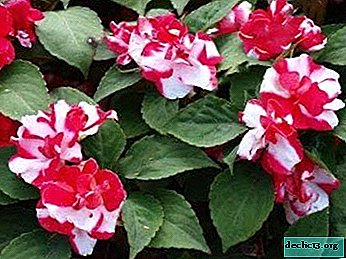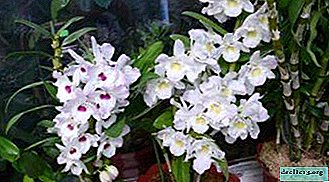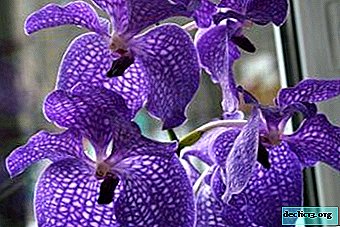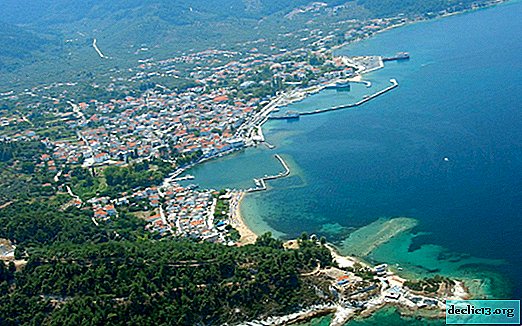Description of varieties and tips for the care of perennial primrose

Primrose, from the Latin Primus (first), is also called the Primrose, since they bloom among the very first flowers in the early spring, when even the snow has not completely melted yet.
They grow mainly in Asia, Western China and the Himalayas (300 species), the rest in Europe, Russia, Transcaucasia (33 species). It prefers humid habitats, but with light soil: meadows, banks of reservoirs, plain and mountain rivers. About the types of this beautiful flower, its beneficial properties and application, read the article.
Types and Description
ATTENTION: Mostly primrose species are perennial; biennial and annual grasses are less common. Flowers are solitary or collected in pyramidal, spherical, pillow-shaped, tiered (candelabrum), carpal (bell-shaped) and umbrella inflorescences.- Pillow-shaped. The flowers of these species are solitary on short peduncles, slightly rising above a pillow of leaves.
- Umbrella. Flowers are collected in a one-sided or round umbrella on one peduncle.
- Capitate (spherical). Dense capitate inflorescences.
- Tier (candelabrum). Inflorescences in several tiers.
- Bell-shaped. Inflorescences from drooping or dangling flowers.
According to the classification of the Royal Society of Gardeners of Great Britain, there are 3 garden groups of primroses:
- Candelabrum (longline).
- Auricular (ear-shaped). In turn, they are divided into alpine (on the open ground), border (flower beds), exhibition (potted).
- Primrose polyanthus.
Below is a table of varieties with a description.
| Type of primrose | Description | Origin |
| Ushkovaya (bear’s ear, auricle) | Short and thick shovel-shaped bluish pubescent leaves. The shape of the leaves is ovate, stem 5-20 cm in length. At the end of 6-7 yellow, white, purple or purple flowers. | In the mountains of Central Europe, in the Western Alps |
| Obconica (reverse conical) | Squat plant with large flowers. Pale lilac flowers with a yellow eye are formed into umbrella inflorescences. | Found wild in China |
| Toothed (notched) | Reaches 30 cm in length and across. The leaves are wide oblong-oval 20-40 cm in length, serrated at the edges, wrinkled. Flowers (1.5 cm) are purple, lilac, red, white are found. | Mountains of Southeast Asia, Himalayas, China and Indochina |
| Stemless (ordinary) | Flowers on short pedicels 6-10 cm, leaves green, wrinkled, serrated at the edges. The shape of the leaves is oblong-oval, lanceolate, 5-25 cm long and 2-4 cm wide. Single flowers are light yellow or white with a bright yellow pharynx. | Carpathians, Transcaucasia, Western Europe, Algeria, Middle East |
| Terry Rosanna | Structural leathery leaves with indented veins. The flowers are large (3-4 cm) pink. Height 10-15 cm. Early flowering plant. | Central Europe, Carpathians |
| Night (evening) | Two-year-old medicinal plant 50 cm tall, leaves elongated-lanceolate 25 cm long ... Single yellow flowers. | North America |
| Viale (orchid) | Candelabrum multi-tiered view with candle-shaped purple inflorescences. | Himalayas, Tibet, Western China |
| Candelabrum | Perennial height and width up to 60 cm. Large leaves up to 22 cm long. Small (up to 2 cm) flowers yellow-orange or pink-red are collected in inflorescences of 8-16 pieces. | From the humid mountains of China |
| Siebold | 30 cm high, 45 cm wide. Leaves 20 cm. Flowers from lilac-purple to almost white are collected in umbrella inflorescences of 15 pcs. After flowering, the leaves die off. | Japan |
| Polyanthus (multi-flowered, Victorian) | Biennials. 20-30 cm high. Large flowers are collected in inflorescences of 5-15 pieces, two-tone with a bright eye. | Transcaucasia, Ural, Iran |
| Japanese | Height and width of about 45 cm, leaves up to 25 cm. Small flowers (2 cm) from red-purple to white are collected in 5-25 pieces in 1-6 curls. | From the wet areas of Japan |
| Pink | Deciduous rosette perennial. Height and width 20 cm, leaves up to 20 cm, flowers (2.5 cm) pink-red with a yellow eye collected in inflorescences of 4-12 pieces. | Afghanistan, Nepal |
| Cortex | Height and width 20-30 cm, leaves 9 cm. Flowers (2 cm) elegant bell-shaped pink-red, pink, red-violet collected in inflorescences of 15 pieces. | From the forests of Eastern Siberia and Europe, in shady ravines, along streams and rivers. |
| Danessa | Refers to stemless species. Large flowers are collected in a dense spherical inflorescence. Leaves are rounded elongated. | Western and Central Europe, Carpathians |
| Mealy (sprinkled) | On the leaves, especially on the underside, a plentiful white coating. The height of the plant is 15-20 cm, the leaves are scapular-lanceolate up to 8 cm long, toothed at the edges. Flowers (1 cm) bright or dark lilac with a yellow eye are collected in inflorescences. | Asia |
| Large-flowered (large-cup) | 15-35 cm high, leaves shortly pubescent oblong-ovate with implicit denticles. The length of the leaves is up to 15 cm, width 2-6 cm. The bell-shaped flowers are bright yellow with an orange center, collected 6-20 pieces per inflorescence, which is inclined to one side. | Western and Eastern Siberia, Transcaucasia, Northern Iran |
| Bissa | Perennial up to 60 cm wide and large. Large leaves up to 22 cm long. Small (up to 2 cm) flowers purple or pink-red are collected in inflorescences of 8-16 pieces. | From China |
| Bully | It is similar to Bissa's primrose, the type is longline, height and width 60 cm, leaves up to 30 cm. Flowers from cream to orange, 5 pieces in 5-7 curls. | From the highlands of China |
| Hairy | Evergreen primrose up to 10 cm high, 25 cm wide, leaves 8 cm. Flowers (1.5-2.5 cm), pink-purple with a white eye are collected in umbrella inflorescences of 10-15 pieces. | Pyrenees, Alps |
| Florinda | Deciduous rosette primrose. 120 cm high, 90 cm wide, leaves 45 cm. The flowers are tubular cream, yellow collected in drooping inflorescences. | Southeast tibet |
| High | Height 10-40 cm, wrinkled oval leaves 5-15 cm long, 2-6 cm wide, pubescent. Light yellow flowers (9-15 mm) are collected in umbrella-shaped inflorescences of 10-30 pieces. | Northern Europe, Carpathians, Transcaucasia, southern Siberia |
Photo
Look at the photo of the ear primrose.

And here is a photo of Japanese primrose.

This is how the primrose spherical variety looks in the photo.

The following photo primrose obkonika.

This photo shows evening primrose.

Next photo fine-toothed primrose.

And look at the photo terry primrose.

Below is a photo of a white primrose.

Useful properties of perennial
Primrose greens are rich in ascorbic acid, carotene and essential oils. Their leaves are added to soups and made from them salad. Dried roots and leaves are added to the roast. Decoctions of leaves and infusions of rhizomes used in folk medicine:
- Expectorant for diseases of the upper respiratory tract.
- Pain reliever for rheumatism.
- Diuretic for kidney disease.
- With headaches, neurosis and insomnia.
- For resorption of bruises, hematomas.
For example, a decoction of powdery primrose is used in folk medicine for dermatitis and improve hair growth. Kortuzovidnaya used as an expectorant and painkiller. Decoctions of this type help with epilepsy, from deafness and unconsciousness. The rhizome of a large-cup primrose is used as an expectorant; vitamin C is obtained from flowers and leaves.
Application for a border, beds, flower beds
TIP: Primrose as a groundcover will fit perfectly into mixed flower beds (mixborders) from low perennial plants. Her magnificent varieties will look good in borders.Auriculars (ear-shaped) with pubescent leaves are the most hardy and unpretentious perfect for alpine slides and rocky gardens, rose gardens. The species and varieties of this plant are so diverse that you can create a whole mono-garden only from primroses - primaria.
 Fine-toothed is widely used in gardens and parks as a border plant, on flowerbeds, alpine slides, and groups on lawns. Stemless primrose hybrids are good for potted plants.
Fine-toothed is widely used in gardens and parks as a border plant, on flowerbeds, alpine slides, and groups on lawns. Stemless primrose hybrids are good for potted plants.
Varieties of primrose high are cut. Mealy ones are unusual and refined, but short-lived, they are grown as biennials. Planted along ponds, streams, on shady alpine hills and rockeries (bright flowers look great against the background of rubble and pebbles).
Large-cup photophilous and found in mountain dry places and steppe meadows. It is suitable for borders, rabatka, lawn decoration, distillation.
Sowing seeds
When growing primrose from seeds, it is preferable to plant a flower not immediately in the soil, but seedlings grown in greenhouse conditions. Start sowing seeds should be no later than February, as the primrose rises for a long time, grows slowly and the seeds even before sowing need mandatory stratification (cold treatment).
Stratification lasts 10-25 days at low but positive temperatures (refrigerator, balcony, basement). Germination of seeds goes until the first seedlings appear in 25-30 days at a temperature of 12-18 ° C.
After the appearance of the first 2-3 leaves, seedlings dive and transplanted into separate pots. Strong seeds are planted in open ground after steady heat. Varietal plants should preferably be planted in the second year of life at the end of May.
We talked about the features of planting primrose at home and in the garden, as well as about care and cultivation, in this article.
Garden care
The primrose is sensitive to favorable conditions, responding to a more saturated shade of flowers, large size, abundance and duration of flowering. Early in spring and towards the end of summer, plants are fed with organic fertilizers, humus.
Do not abuse the nitrogen components, otherwise the foliage will go mainly to the growth, and you can not wait for the flowers. Provide maximum watering during flowering (May-June). The earth must be moist and loose, do not forget to loosen it after watering.
Then, during the dormant period (July-August) they monitor only that the land does not dry out. In late August, the primrose begins to grow again and needs watering. After flowering, the leaves lengthen.
When preparing primrose for winter, varietal plants, as less stable and more demanding, cover with leaves and sprinkle the roots with dry nutritious mulch. Leave the leaves for the winter to protect from the cold, and in the spring old overwintered leaves can be cut. So, features of growing primroses:
- Prefer partial shade.
- Well-drained, humus-rich soil.
- Do not tolerate drought.
- Need regular dividing the bush and transplanting.
- The stagnation of water in the soil in combination with hypothermia is detrimental.
Detailed instructions for the care of primrose at home and in the garden can be found here.
Flower transplant
Transplantation is necessary every 3-4 years, and for terry varieties every two years. They do not tolerate open space between themselves, when transplanting, note that the foliage of neighboring outlets should be in contact, the planting should be closed. Small species are planted at a distance of 15-20 cm from each other, large plants 20-30 cm.
Primrose grows best in the shade of garden shrubs and trees, avoiding direct sunlight. The only exceptions are alpine species. She prefers light, moisture-intensive soil with good permeability, in which water will not stagnate.
IMPORTANT: If the soil is heavy, such as clay, additional sand, humus, foliage compost and sphagnum moss (or peat) are added. Neutral soil is preferred.You can read about transplanting and planting primrose in the fall in our material.
Breeding
Primrose is propagated by seeds, division of the bush and leafy cuttings.
 When dividing by shoots in late August or early September, a parent (uterine) plant is taken at 4-5 years of age.
When dividing by shoots in late August or early September, a parent (uterine) plant is taken at 4-5 years of age.
It is abundantly watered, dug from the ground and the roots are shaken off. With a sharp knife, they are divided into roots into several parts, sliced with activated charcoal or ash, and immediately planted on new plots
If the plant has only one rosette, you can propagate it with axillary shoots. The leaf of a primrose with a petiole and a bud is separated from the parent plant, the leaf is cut halfway and transplanted into a prepared nutritious, moderately moist and loose soil.
The cuttings are germinated at a temperature of 16-18 ° C in a bright place, but without direct sunlight. When shoots with 3-4 leaves appear from the kidney, they can be transplanted into separate pots and planted in open ground in spring.
Propagating by seeds is quite time-consuming; cold pre-treatment is required (stratification) within 3-4 weeks. Then the seeds are germinated for 30 days at a low temperature of 12-18 ° C.
After the first leaves appear, the sprouts are dived and planted in pots for growing strong seedlings (for details on how and when to plant primrose, and also to grow and propagate a flower, read here). In open ground, seedlings are planted the next year.
Primrose will be a real salvation of your garden if it cannot boast of sunny areas. The views of this primrose are so colorful and diverse that it is possible to create a mono-garden, consisting entirely of only these flowers - the primaries.
Useful video
Watch the video about the types of primrose, cultivation, reproduction and its beneficial properties:

















